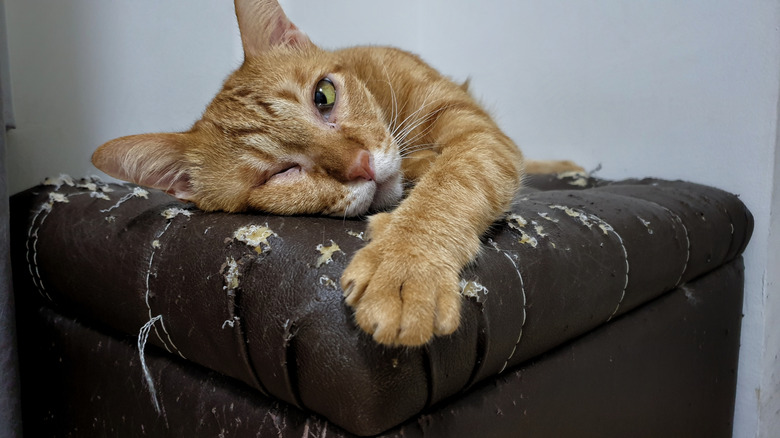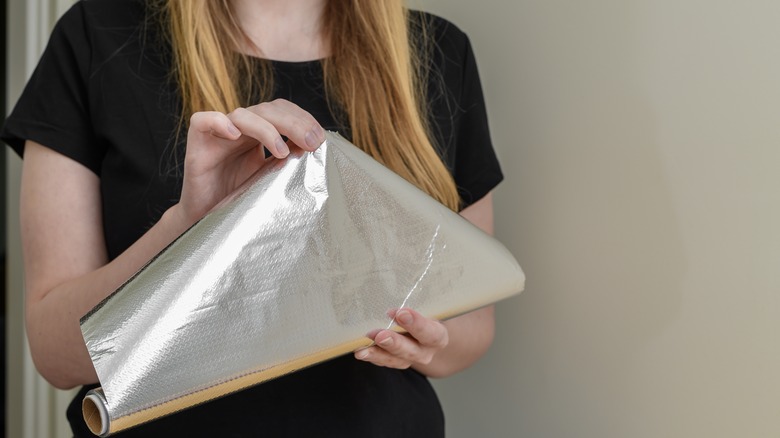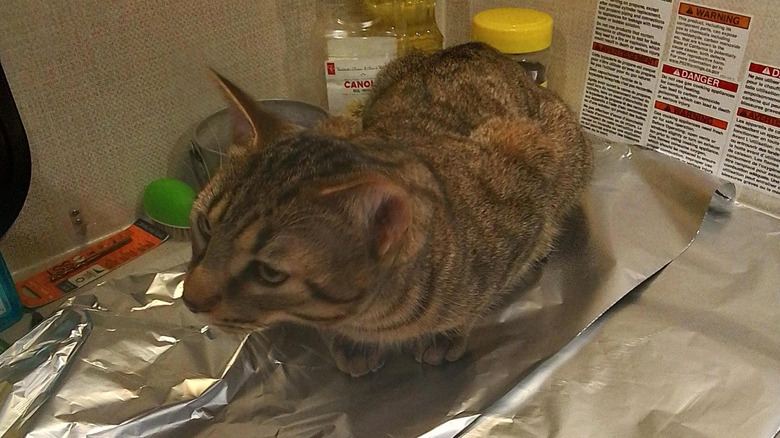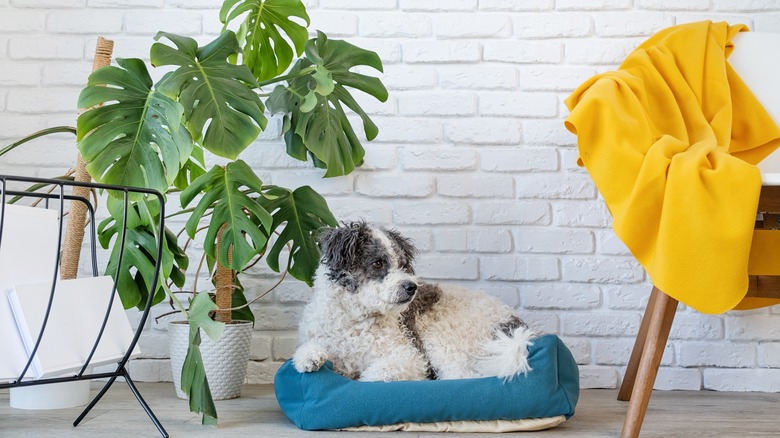Does Aluminum Foil Really Keep Pets Off Furniture? Their Humans Would Like A Word
Frustrated with your pets' tendency to treat your furniture like their personal playground? In an effort to stop their cats and dogs from destroying yet another couch, caretakers are turning to aluminum foil as an unexpected but effective solution to keep their furry companions away from off-limits spaces. Thanks to its simple and budget-friendly nature, aluminum foil is becoming the go-to trick for keeping cats and dogs at bay. With just a quick crinkle and a few well-placed sheets, this common kitchen staple is repurposed into a clever deterrent.
As to how well the aluminum foil trick really works in the battle to protect your furniture from claws and paws, the answer comes in varying shades of "yes" and "no." Results have varied wildly among pet parents and presented various pros and cons. After all, aluminum foil is unlikely to go with your living room décor, so it isn't a feasible long-term solution. It can also have a negative impact on your pet's well-being, calling any benefits it might offer into question. That said, tales (pun intended) of aluminum foil foibles abound, and can offer a more nuanced look.
Why aluminum foil works as a pet deterrent (at first)
Pet parents have discovered that aluminum foil deters cats and dogs due to its unique combination of sensory triggers. The crinkling noise created when pets step on it is particularly jarring to a cat's sensitive hearing and can startle even the bravest of dogs. Likewise, the unpleasant texture of foil under their paws makes it uncomfortable for pets to walk on. Cats especially dislike the feel of aluminum foil, often avoiding it altogether. Thus, it has become an effective (if undesirable approach) for keeping cats off the table and other surfaces.
In addition to sound and texture, the reflective nature of aluminum foil can confuse or scare pets. Cats, for instance, might be startled by their own reflection, reinforcing their avoidance of the foil-covered areas. This multi-sensory experience makes aluminum foil a useful, though short-term, solution for keeping cats and dogs from chewing on and damaging furniture.
Pet parents have employed various methods using aluminum foil to deter their furry companions' undesirable behavior. Some have found success by wrapping scratching posts with aluminum foil to stop cats from damaging furniture, while others have covered countertops and furniture surfaces with foil sheets to prevent pets from jumping up. Additionally, "wallpapering" furniture edges with foil has been used to protect specific problem areas like couch corners. For dogs, some pet parents line baking sheets with foil and place them on couches to startle them when they jump up, and others have used aluminum cans or plastic bottles as noise makers to enhance the deterrent effect.
The effectiveness of aluminum foil could diminish as pets get used to it
Aluminum foil may work wonders in the beginning, but many pet parents find that its power fades over time as their pets get wise to the trick. What once startled or deterred them becomes part of the furniture — literally! Redditors on r/CatsAreAssholes and r/AnimalsBeingJerks have related multiple stories about their pets overcoming their initial fear of foil.
Redditor beautiful_life555 shared a photo of their satisfied-looking cat curled up napping on a tinfoil-laden sofa, reporting the consolatory "At least it worked for the dogs." Then again, not all felines are immune to the shiny stuff, as evidenced in Redditor N7_Hades' video compilation of cats startled skyward by well-placed tinfoil along kitchen counters and bathroom sinks. In a similar manner, an Imgur post featuring a dog with sad eyes put off from sleeping on the couch by tinfoil has garnered over 1.6 million views. The pic attracted dozens of comments, with reactions ranging from amusement to concern about the dog's comfort. Viewers expressed their thoughts through the comments, often blending humor with sympathy for the pup.
In the end, while aluminum foil may work as a short-term solution, it's rarely a permanent fix. Pets are smart, and they'll figure out that the foil is harmless eventually. For long-term success, pairing foil with positive reinforcement training or alternative deterrents — like scratching posts for cats or motion-activated sprays — can help extend the effectiveness.
Aluminum foil drawbacks and long-term solutions for keeping pets off furniture
While aluminum foil can temporarily deter pets from venturing where they shouldn't, it has notable drawbacks. Some pets, particularly those with nervous dispositions, may become stressed or anxious due to the crinkling sound and texture of aluminum foil. This stress can lead to behavioral issues such as hiding or increased agitation. Additionally, a major concern is the risk of ingestion. If pets chew or swallow foil, it can cause choking or intestinal blockages, requiring immediate medical attention. Dogs, in particular, may associate foil with food, especially if they've discovered delectable morsels wrapped in it in the past.
Moreover, it's important to note that aluminum foil only addresses the symptoms of unwanted behavior, not the root causes. Cats scratch to stretch or mark territory, and dogs often jump on furniture for comfort. Without offering alternatives, like scratching posts or dog beds, the behavior may persist elsewhere. For example, pets may simply move to uncovered areas, continuing their behavior on other furniture. This makes foil a short-term fix rather than a comprehensive solution. Aluminum foil can be effective temporarily, but pairing it with positive reinforcement, training, and proper outlets for behavior is key to long-term success. You may also want to stay away from aluminum foil altogether to avoid introducing an unnecessary stressor into your pet's life.



